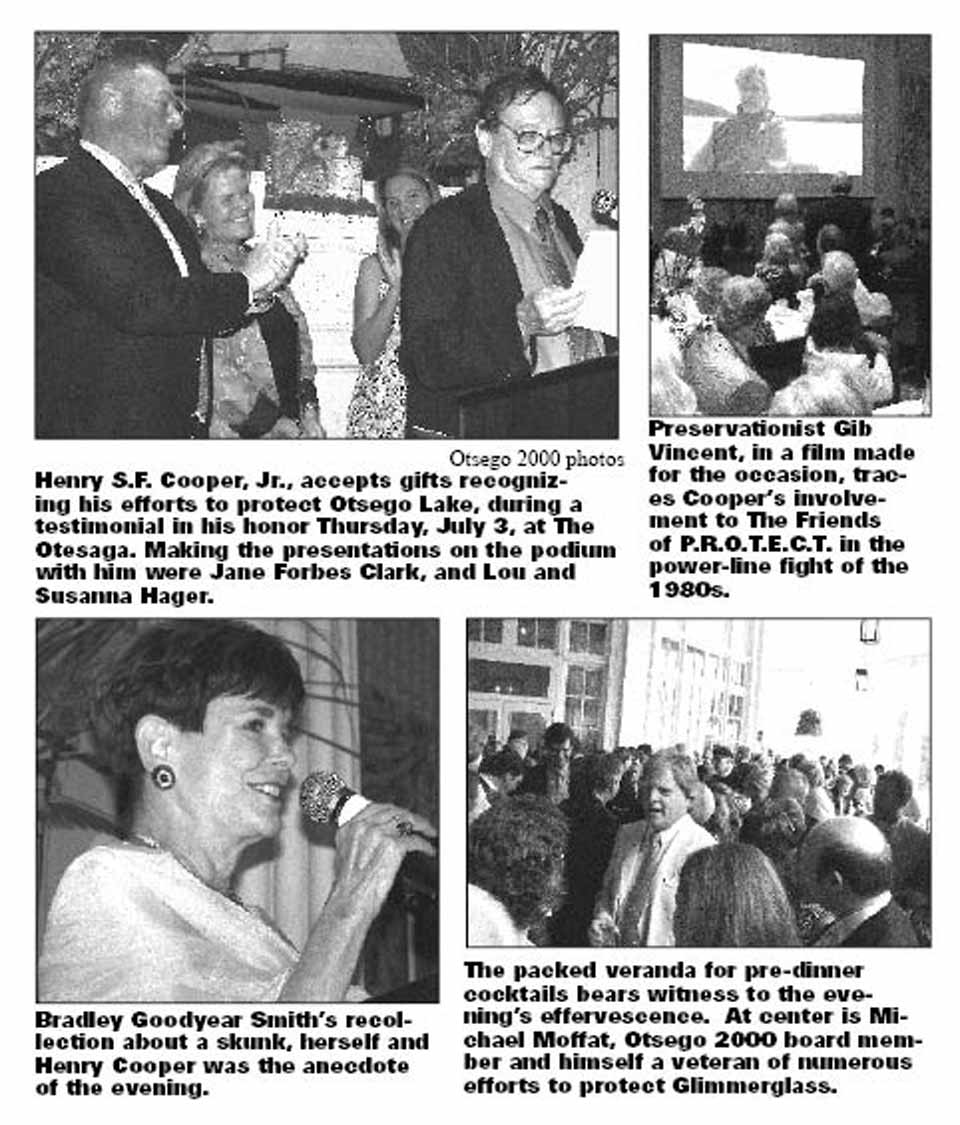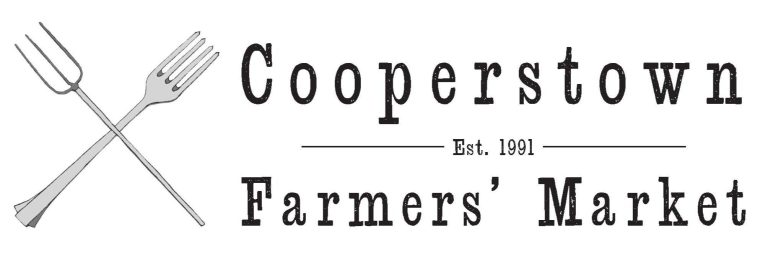In 2008, Henry Cooper Toasted
For His Gentleness, Sense Of Fun

Editor’s Note: This is reprinted from The Freeman’s Journal edition of July 11, 2008, after Henry S.F. Cooper Jr., who passed away early today, was celebrated at a testimonial in his honor at The Otesaga, attended by 220 of his many admirers.
By JIM KEVLIN • from The Freeman’s Journal
COOPERSTOWN – Everybody agreed Bradley Goodyear Smith’s story best captured Henry S.F. Cooper, Jr.’s gentle personality.
On her way to a party, her car hit a skunk and she ended up smelling like one.
At the party, everyone stayed away. Except Henry Cooper, who insisted on repeatedly twirling her around the dance floor.
On her way home, she realized the aroma was so strong Henry must have ended up smelling like a skunk, too.
When the guest of honor took the podium to address 220 well-wishers at Otsego 2000’s Thursday, July 3, testimonial in his honor, he wouldn’t let Bradley Smith get away with making him seem like a nice guy.
“What makes you think I don’t like to smell like a skunk?” he asked.
There were more serious stories, but the skunk one captured the evening’s light-heartedness.
All the guests had been looking forward to celebrating a guy they really like, and the effervescence bubbled over in pre-dinner cocktails on The Otesaga’s veranda and in the ballroom feast – filet mignon and salmon – that followed.
Everyone was there. Jane Forbes Clark, in a brilliant light blue jacket, sat to the guest of honor’s right. (She later joined Lou and Susanna Hager to make the presentations.)
As dinner ended and the speechifying began, everyone munched on macaroons. (As editor of The Century Bulletin, Henry chronicled The Century Club’s loss of its macaroon supplier, a tragedy the New York Times picked up on and reported about in February.)
But there was a serious element to the evening as well, as speaker after speaker – many in a short film put together for the occasion – recognized Henry S.F. Cooper, Jr.’s role over the past 30 years in:
- One, recognizing the neighborhood around Otsego Lake is a special place.
- Two, raising the necessary funds to keep it safe from challenge after challenge and
- Three, contributing his time, presence and voice in meeting after meeting in ensuring the case for preservation was eloquently made.
In an interview at his Red Creek Farm home a few days later, Henry Cooper was still giddy about the evening.
“I enjoyed myself immensely,” he said emphatically. Beyond knowing he was going to be recognized in some way, “I did not know anything about what was going to happen.”
In addition to all the personal tributes, he remarked on the letter from Gov. David Paterson, which described the honoree as “a motivational and gracious leader whose life’s work promises to continue contributing in a meaningful way for generations to come.”
A letter from George and Laura Bush is on the way as well.
Henry S.F. Cooper, Jr., was born in New York City but, a direct descendant of Judge William Cooper and James Fenimore Cooper, he was tied to Cooperstown from the outset.
His father, Henry S.F. Sr., was one of the young doctors who brought deserted Mary Imogene Bassett Hospital back to life in the 1920s, and the son spent virtually all his boyhood summers in these parts.
From 14 to 22, he raked hay on the family farm, beginning before the days of baling, when loose hay had to be pitchforked up a conveyor on the back of a wagon, then again into the barn.
Ask him about Angus, his mother’s yellow 1929 Model A that sister Susie – now Susie Weil – had painted plaid while their parents were away for a week in Bermuda. After getting over her fury, mom gave the car to Susie, who passed it down to Jimmy (ask Andy Blum about that) and then to Henry.
“It’s still somewhere in one of the barns,” the last owner allowed.
At Yale, Henry Cooper wrote avidly for the Yale Daily News, ending up with a column, “Sound and Fury.”
In the summer of 1956, his nephew Henry Weil relates, his uncle wanted to go to the Middle East, but his mother wanted him to get a paying job. So he called the Herald Tribune and talked them into paying him for writing a series of articles on his travels.
And the Arab countries he visited – “they weren’t used to getting any attention back then,” said Henry Weil – rolled out the red carpet.
“They had colleges. But, apparently, only the children of royalty went to the colleges,” said the nephew. “They figured Uncle Henry was an earl or something.”
As it turned out, Henry Cooper was on the dais when the British ambassador turned the Suez Canal over to Nasser. The mostly non-Egyptian crowd gave Nasser a bit of a chilly reception and the Yale undergrad “took it upon himself to console the guy,” an indication of his uncle’s ability to empathize, Henry Weil said.
Henry Cooper has a plentiful supply of stories about fighting the good fight to preserve Otesgo Lake, from the Marcy South line, to formation of the Lindsay Patent and Glimmerglass national historic districts, to the successful efforts of the past two years to push back an army of 400-foot-tall windmills from the view shed.
Before Marcy South, he said, people took the natural beauty around them for granted; controversy changed that. “People began to think of our area as a special landscape and the lake as a national treasure.”
And an as-plentiful supply about his 25 years at the New Yorker magazine, where – launched by a Talk of the Town piece on the lunar module Grumman was building in Bethpage, a local story – he specialized in the pioneering days of the space program, writing long essays that eventually became books, seven in all. (His book on the near-disaster of Apollo 13, rather than astronaut Jim Lovell’s memoir, incomplete at the time, was a source for the hit movie with Tom Hanks, the directed acknowledged at one point.)
He’d had his sights on the New Yorker since he was 16, and getting out of Yale went to see Leo Hofeller, the magazine’s executive editor, who handled the hiring. “We see you can write in New Haven,” Hofeller told him. “But we don’t know if you can write in New York.”
He sent Cooper away with an assignment to write two “Talk of the Town” pieces. Before he could, he was drafted into the Army, spending two years stateside as a clerk-typist.
Discharged, he called Mr. Hofeller back and advised him he would stop by to see him the following Tuesday at 4.
“Listen, young Cooper,” the executive replied tartly, “I don’t want to see you – you want to see me,” although he did schedule the “chagrined” applicant a few weeks hence. First question: “Where are those two ‘Talk of the Town’ stories I asked you to do two years ago,” and sent him on his way with the admonition: “Don’t bring them in; send them in. Don’t call me; I’ll call you.”
Cooper did the two pieces – one on a cockroach hunter, the other on a weather forecaster ensconced in a castle in Central Park – sent them in and, hearing nothing, enrolled in the Columbia School of Journalism, where he spent a couple of miserable months.
Then the phone rang. It was Hofeller. “Mr. Shawn wants to see you,” he said.
“Who’s Mr. Shawn?”
“My god, you want to work for the New Yorker and don’t even know who the editor is!”
In any event, Henry Cooper went to see the famously shy Shawn, who said only, “When can you start?”
When he was a boy, Henry Sr. used to read James Fenimore Cooper’s novels out loud to his children, who would stretch out on the carpet and try to catch a nap while dad intoned about Hawkeye and his pals. As he grew, Henry Jr. continued to avoid the novels.
Shortly after he joined the New Yorker he went to a cocktail party in the city and he ran into Louis C. Jones, the long-time NYSHA director, who asked him about his famous novelist ancestor.
When Henry said he hadn’t read much Cooper, Jones replied, “that’s the most absurd affectation I’ve ever heard of.” Chagrined again, Henry Cooper immersed himself in The Leatherstocking Tales, (even trying to indoctrinate daughter Lizzie, as unsuccessfully as Henry Sr. had him.)
Henry Weil said one thing people don’t immediately recognize about his uncle is his sense of fun, and he went on to tell of some quite hilarious practical jokes, but strictly off the record.
Still, that sense of fun was manifest a couple of years ago when Henry Cooper went to Rome to visit his younger daughter Molly, a director working on “The Life Aquatic,” the Jacques Cousteau spoof starring Bill Murray. (Eldest daughter Lizzie is a newspaper reporter in Utica; middle daughter Hannah is a college professor.)
The actor who was to play a TV interviewer of Cousteau/Murray in the movie had flown into town and immediately had a stroke.
“We’ve been calling all over the world,” Molly told her father at dinner in a restaurant he hadn’t dined at in 30 years, “and we can’t find a replacement.”
“How about your old man?”
“Oh, daddy,” was Molly’s reply.
The next morning, however, she called back. He auditioned and got the part. You can order the CD at Box Office Video.
Meanwhile, if you see Henry S.F. Cooper, Jr. riding Otsego Lake’s waves aboard “The Life Aquatic,” you know what that’s all about.





